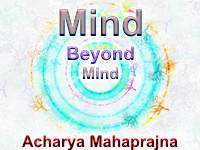
.
What is the purpose of spiritual exertion, meditation and Sadhana? In what relation do they stand with the practitioner and the world around and within him? Before he begins meditation practice, the practitioner must raise and try to answer these questions.
Natural philosophy is concerned with describing and explaining what is. The normative sciences are concerned with the question of what ought to be. They are concerned with values or with the ideals of individual and social life. Moral philosophy begins with the question: What do I propose to be and for what purpose?
Jain Agamas (scriptures) speak of two kinds of consciousness. The first is consciousness determined by the instincts or what is called objective consciousness. The second is Kevala Cetana or pure consciousness. It may also be called self-consciousness. In it there is no object. A Vitaraga person, i.e. one who has renounced all kinds of attachments and aversions, possesses pure consciousness, i.e. consciousness, which has no referent. When consciousness refers to an object that object determines it. This is called Smajnopayukta Cetana.
There are ten Smajnas or instincts:
| | Ahara (hunger) |
| | Bhaya (fear) |
| | Maithuna (sex) |
| | Parigraha (the acquisitive instinct) |
| | Krodha (anger) |
| | Mana (pride) |
| | Maya (deceit) |
| | Lobha (greed) |
| | Loka (body) |
| | Ogha (instinct at the animal level) |
The supreme purpose of Sadhana is to disassociate the soul from all kinds of objects or Samjnas. It does not aim at acquiring supernatural or miraculous powers. It simply aims at self-purification. Does it mean giving up food? So far as the body is alive, it is not possible to give up the instinct of hunger. No body can perform Sadhana by remaining hungry. The body is the means of Sadhana and for that reason it is necessary to maintain it. However, it is possible to give up attachment to and craving for food.
The Samjnas or instincts contaminate consciousness and it becomes necessary for the Sadhaka to purify it. By its very nature it is pure, but instincts and feelings make it filthy. In a state of impurity it is not able to reflect things as they are. The purpose of Sadhana is to revive the original nature and purity of consciousness. Sadhana aims at the attainment of pure knowledge. It implies the elimination of instincts and feelings in order that they may not contaminate knowledge. This can be achieved by anybody and at any time. It is not only the aim but also the starting point of Sadhana, which cannot be accomplished without the practice of Kevala Jnana. The material cause is not qualitatively different from the effect, which it produces. Kevala Jnana is the material cause of what we want to achieve through Sadhana and it is also the end product of Sadhana. Pure knowledge will be impossible to achieve, if consciousness were not pure by its very nature.
Let us digress a little on the nature of a material cause. The cause becomes the effect. If it does not become operative at the very moment when it comes into existence, it will never produce the effect. If the pot made by the potter does not break at the moment when it had come into existence, it will never break. If a child does not die at the very moment of its birth, it will never die. Once pure knowledge has been attained, it will never disappear. If it disappeared, it was not pure knowledge. It comes into being at a certain stage of Sadhana once it has arisen, it will always continue to hold its ground.
Sadhana also aims at purifying the Prana force, at isolating it from instincts and feelings. How can this be done? It can be done through the development of transcendental consciousness. Citta (consciousness) is of two kinds: Laukika (this-worldly) and Lokottara (transcendental). The former is alloyed with feelings and the ten instincts referred to above and the latter is free from them. It is the same consciousness, which assumes these two forms. The same Prana force flows through both the forms of Citta.
 Acharya Mahaprajna
Acharya Mahaprajna

